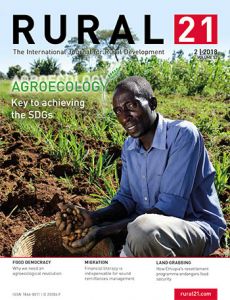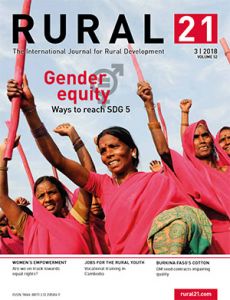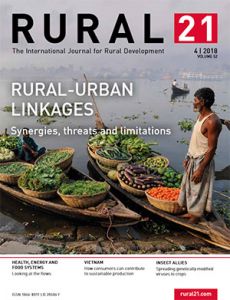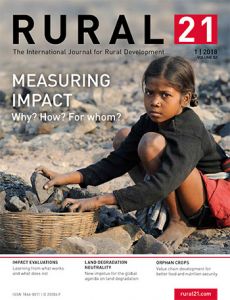Jahrgang 2018
-
Rural 21 (engl. Ausgabe 2/2018)Focus 2/2018: Agroecology
In 2008, the authors of the International Assessment of Agricultural Knowledge, Science and Technology for Development (IAASTD) report arrived at the conclusion that “business as usual is not an option” to make global food security sustainable. The radical transformation of the existing food and agricultural system that the report calls for was initially given a lukewarm reception by many international organisations. But the adoption of the Sustainable Development Goals provided the demands raised in the IAASTD report with new impetus. This edition illustrates the concept and the different definitions of agroecology. In addition, we asked representatives from various institutions – UN Organisations and research institutions, German and Swiss development co-operation, the German Agricultural Society and non-governmental organisations from the Global South – to inform us about which aspects of the agroecological approach they attach particular importance to and how this affects their own activities. Erfahren Sie mehr -
Rural 21 (engl. Ausgabe 3/2018)Focus 3/2018: Gender equity
No doubt a lot has happened in terms of gender equity and equality over the last few decades. There are women who head states and hold high positions in international organisations. There are women who successfully lead enterprises and have long ceased limiting their role to that of a caregiver. But progress is extremely slow. And some of it has been reversed, as the 2017 Global Gender Gap Report of the World Economic Forum notes. In 27 out of the 144 countries examined, progress towards gender parity is once again regressing. And since the #MeToo movement at the latest, it has become frighteningly clear just how commonplace it continues to be to mercilessly take advantage of the power structure between men and women – in order to inhibit, humiliate, sexually molest, hit and kill them. Whether we are in the Global North or the Global South makes little difference in this context. Gender equality and women`s empowerment represents a topic that is far too complex to be dealt with comprehensively in one single edition. We can only deal briefly with many of the areas that it no doubt encompasses, including both those mentioned above and education, the digital gender divide, reproductive health und female genital mutilation. We nevertheless hope that our selection of themes will make you more aware of this topic. Erfahren Sie mehr -
Rural 21 (engl. Ausgabe 4/2018)Focus 4/2018: Rural-urban linkages
By 2050, two thirds of the world’s population are expected to live in cities. The United Nations New Urban Agenda implies changing diets and thus the need to include sustainable food systems for the cities. So the rural areas have to transform in parallel. Secondary cities are growing enormously in the rural areas and play a crucial role in coping with waste management or wastewater treatment and other problems that are arising. Spatial regional planning approaches have to be adjusted to take rural and urban development into account in parallel. Do rural surroundings really feed urban areas? And what about other flows such as cash in form of remittances, or the dynamics of geographical closeness which can lead to health risks? Land and resource conflicts may arise when cities are growing, and the demand for goods and services is changing production in the rural areas. Do such linkages pose an advantage or a threat? This edition provides advices and examples of best practices as well as failures to bridge the gap between rural and urban regions. Erfahren Sie mehr -
Rural 21 (engl. Ausgabe 1/2018)Focus 1/2018: Measuring impact
On average, 400,000 US dollars and a period of three years is needed to measure the effect of a development intervention, the International Initiative for Impact Evaluation concludes from its activities. These are valuable resources that need to be used carefully. Our authors describe which impact measurement methods have proved to be useful during the last few years and what their strengths and their limits are. And they demonstrate when impact evaluations make sense – and when they don’t. Erfahren Sie mehr






